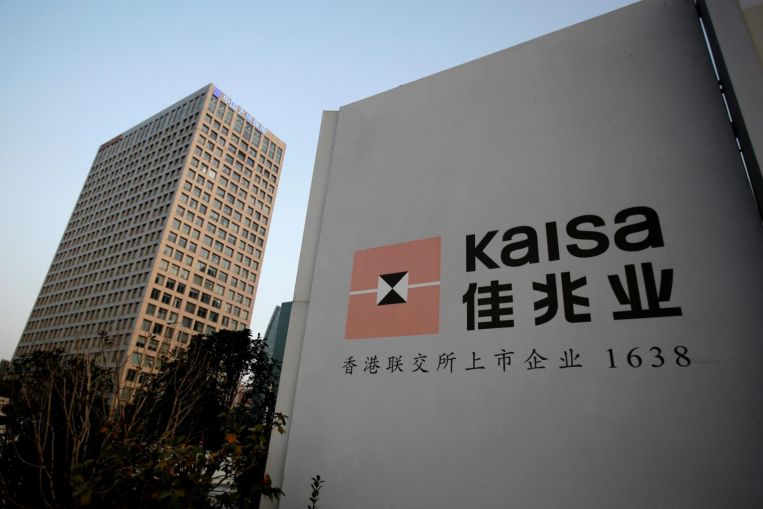BEIJING (BLOOMBERG) – Investors searching for the next flashpoint in China’s crisis-hit real estate sector are focusing on Kaisa Group Holdings.
Having gained notoriety in 2015 when it became the first Chinese builder to default on dollar bonds, concerns for Kaisa’s financial health are mounting at a time when soaring borrowing costs squeeze property firms with the worst balance sheets.
The developer has a US$400 million (S$540.4 million) note due on Dec 7, and US$2.8 billion of dollar bonds maturing in 2022, according to Bloomberg-compiled data. Kaisa’s shares tumbled after downgrades from credit rating agencies last month, while its US dollar bond maturing in December has plunged from around par in September to 59 cents on the dollar. Bonds maturing after 2021 are trading at even lower levels.
What’s the company?
Founded in 1999, the Hong Kong-listed firm operates in more than 50 cities in China, according to the company’s website. In addition to core real estate operations, Kaisa has businesses in health care, transportation and owns a football club. It ranks as China’s 27th biggest property developer by contracted sales as of October, according to a list compiled by China Real Estate Information Corp.
Since completing a debt restructuring in 2016, it has grown to become China’s third-largest dollar debt borrower among developers with more than US$11 billion of dollar bonds outstanding.
What’s happening?
Kaisa canceled meetings with investors in October, triggering concerns about its liquidity situation and sending its dollar bonds lower. Downgrades by both S&P Global Ratings and Fitch Ratings a few days later caused a fresh sell-off in the developer’s shares, which have tumbled nearly 70 per cent this year. Its dollar bonds are among the worst performers in a Bloomberg index.
One major holder has exited at a loss. Chinese Estates Holdings, a Hong Kong real estate firm run by the family of billionaire Joseph Lau, sold the last of its Kaisa bonds at the end of October. It expects an aggregate loss of US$174 million on its position this year. Reuters reported that Kaisa is seeking buyers for its Hong Kong-listed property management unit and two residential sites in the city, but no clear buyers had emerged.
Why does it matter?
Mounting scrutiny on Kaisa comes amid fragile confidence in China’s property sector. At least four developers defaulted on dollar bonds last month and others are scrambling to avoid that fate. A record pace of defaults and downgrades for Chinese borrowers recently sent junk dollar bonds yields to a decade-high.
Such surging borrowing costs have shut down offshore refinancing channels for Chinese firms. This has mired many in a negative cycle in which they are forced to reduce spending on land and construction to preserve cash for debt repayment, leading to sales declines that further restrain spending.
Kaisa’s dollar bonds are actively traded and any big price move on the notes would typically cause others to follow suit. A potential default could roil the nation’s high-yield market and further dampen investor sentiment, making it even harder for the sector to refinance.
What does the company say?
Kaisa said in its interim report that it “implemented a series of debt management measures” in terms of offshore financing in the first half of 2021.
The developer said it has “successfully and effectively” lowered its financing barriers. As of June 30, the firm had around US$7.6 billion cash and bank deposits, representing an increase of 3.4 per cent compared to levels as of end-2020, according to its filing.
What do rating agencies say?
Kaisa was downgraded by three global rating agencies last week, all raising concerns about its ability to refinance and address upcoming debt maturities. The company was cut two notches to CCC+ by S&P and Fitch, and to Caa2 from B3 by Moody’s Investors Service. The firm’s “funding access has further weakened, as demonstrated by its highly volatile offshore bond prices,” Moody’s said.
Kaisa will need to sell assets to help avoid default, although such sales may not be completed in time to cover bond maturities, S&P analysts wrote. The company will need to manage a further US$2.2 billion to US$3 billion of offshore maturities per year over 2023-2025, according to S&P.
What are traders watching for next?
Kaisa has two interest payments due in the second week of November – US$58.5 million on a note maturing 2025 and US$29.9 million on a 2023 note. Investors are also keeping an eye on its next big payment when its 6.5 per cent dollar bond falls due in December, with US$400 million outstanding and US$13 million in interest.
Join ST’s Telegram channel here and get the latest breaking news delivered to you.
Source: Read Full Article
